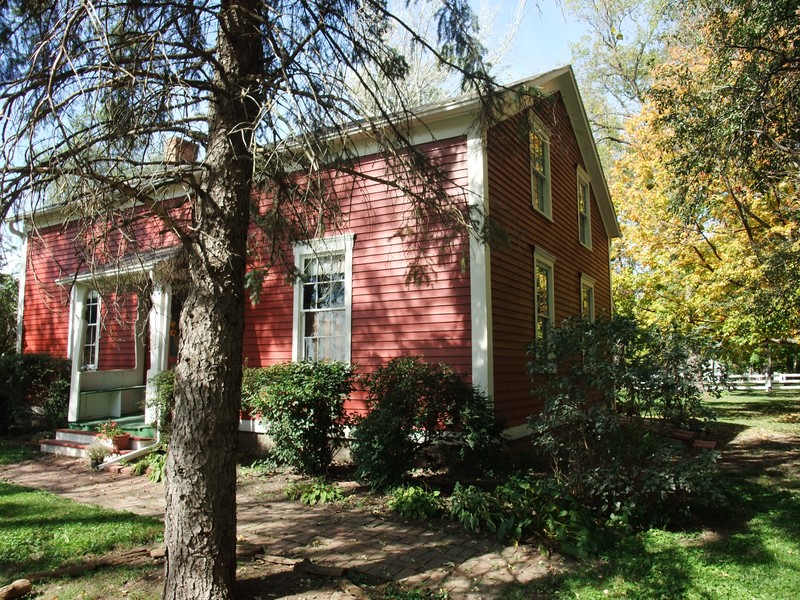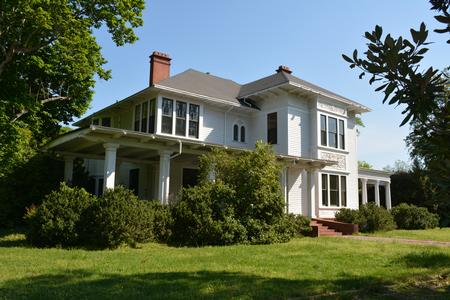From The Archives
1855 Saltbox
Bishop Hill, Illinois 61419
Red Oak House

A piece of historic Bishop Hill- Utopia on the Prairie. This 1855 home known as the Red Oak House sits on a nearly 1/2 acre shady lot in quiet Bishop Hill. Featuring 4 bedrooms (could be 5), lots of closets, 1 1/2 baths, modern kitchen with handcrafted cabinets. Beautiful natural pine wood floors. Central air, new furnace in 2013, new hot water heater in 2016, wood burning stove in living room.
Scroll down below the map for more information
Scroll down below the map for more information
| 1.5 Stories | |
| Bedrooms | 4 |
| Full Baths | 1 |
| Half Baths | 1 |
| Heated Sq. Ft. | 1,188 |
| Acres | 0.5 |
Features.
- 1st Floor Bath
- 1st Floor Laundry Room
- Basement
- Dining room
- Dry Basement
- Entry Hall
- Kitchen
- Living room
- Walk out Basement
- Master bedroom downstairs
- 1 Car Garage
- Barn
- Porch
- Workshop
- High Ceilings
- Wood floors
- Central air
- City water supply
- Dishwasher
- Gas heating
- Range
- Refrigerator
- Septic Tank
- Water Heater - Gas
- Hand-hewn Beams
- Plaster Walls
Local / Regional Links.
Learn about the town of Bishop Hill and all it has to offer.
Bishop Hill Heritage Association
BHHA maintains the historic properties and the Swedish culture unique to Bishop Hill.
No Contact Information.
This listing is archived and is not for sale.
Contact information is not available for archived listings.
Background
The Red Oak House is a timber frame “saltbox” dwelling originally built in 1855 on the first tract of land purchased by the Bishop Hill Colony. It was occupied by the Colony farm workers working the land and tending the livestock at Red Oak. In 1966, the house was moved into Bishop Hill to 310 E Knox St and underwent extensive restorations. The house is 1-1/2 stories with a partial brick basement. It has five rooms on the first floor with a center stairway and hall. The front porch was built by Hans Brunk, an emigrant from Sweden, who has built similar porches in Sweden.The Red Oak House maintains much of its original character from 1855. It is one of the two surviving agricultural outposts from the original five.
Historic Bishop Hill
Bishop Hill, Illinois is a “historic village” established in 1846. It stands out as one of the best-preserved examples of the religious Utopian colonies which occupy such a distinctive place in the nineteen century American cultural scene. It is the only such Swedish society in America.Bishop Hill is still very much the same town you would have seen 160 years ago with most of the original historic structures still in use today. It is a living, fully functional village with a mayor and fire department. What makes it unique is that the entire town is a registered historic landmark. The crafts and trades that supported the forefathers and mothers are still a source of livelihood today. The people who live here still farm the surrounding countryside, cut fire wood, plant broom corn, and celebrate the changing seasons, just as their Swedish ancestors did.
The town boasts seven museums, four eating establishments, two B&B's, and many small shops and craft studios. Numerous festivals are held throughout the year and the town attracts visitors from all parts of the USA and from overseas. Bishop Hill has an active Arts Council as well as the Heritage Society and Old Settlers. The Red Oak House is part of this historic town.
The Bishop Hill Colonists owned several thousand acres of farm land, collectively. A major issue was traveling between the Colony and the fields each morning and evening. A solution to this time-consuming travel problem was the decentralization of certain farm workers who lived in the village. Several outlying farm centers were maintained as agricultural outposts of the Colony. The Red House in Red Oak (Red Oak House) was one such agricultural outpost.
Archived in January, 2017
Comments & Feedback
All information deemed reliable but not guaranteed and should be independently verified. All properties are subject to prior sale, change or withdrawal. OldHouses.com is not responsible for any typographical errors, misinformation, misprints and shall be held totally harmless.


 OldHouses.com headquarters, Union, SC.
OldHouses.com headquarters, Union, SC.




